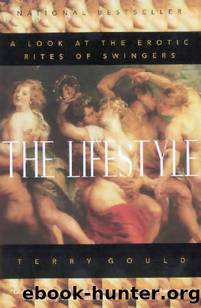The Lifestyle: A Look at the Erotic Rites of Swingers by Terry Gould

Author:Terry Gould [Gould, Terry]
Language: eng
Format: epub
Tags: Family & Relationships, Marriage & Family, Non-Fiction, Sexuality, Social Science, Sociology, Wife-Sharing
ISBN: 9780307369291
Google: qeT_3HrQXAkC
Amazon: B003TFEFOA
Publisher: Vintage Canada
Published: 2010-06-17T23:00:00+00:00
Sherfey published her theory in 1966 in The Journal of the American Psychoanalytic Association—the most respected in its field—and republished it in book form in 1972. As can be imagined, it was widely discussed and people breathlessly wondered if women would really behave that way if they ran the world and were given the total freedom to have sex with whomever they wanted. Evolutionary biologists soberly argued that, yes, women could behave that way, but most women wouldn’t. A quick comparison of the “hinder end” of a monkey and the anterior side of even the most aroused female tells the story, they said. Ovulating women do not exhibit the irresistible sexual swellings of other primates that make them Sherfian creatures for a time. In human females ovulation is “hidden.” Hidden ovulation was for a long time assumed to be the great divide between human females and nonhuman female primates. The various explanations given for the evolution of concealed ovulation rest on what might literally be called a motherhood issue: the helplessness of the human infant at birth. This, in part, say the theorists, accounts for the evolution of monogamy and human female choosiness—the natural way to be. Let’s have a look at this theory.
At some point in evolution, probably about three million years ago, the pelvic changes required to accommodate the upright posture of early humans made it more difficult for females to bear their large-headed young. The solution selected for by nature was for the mother to bear offspring at an earlier stage of their development. The evolutionary difficulty, however, was that the infant was left so needful at birth that for at least four years considerable nurturing was required just to keep it alive. Also, if one assumes that women did not run the group of early humans or raise their children in primitive “day cares,” infant helplessness necessitated that the father lend consistent support to the mother. If in a group of male-dominated Homos females were flying fertile sexual flags everywhere a male looked, and he was being approached by those females, he might be tempted to leave his defenceless “wife” and offspring, and go off and have intercourse willy-nilly. But if all the women in the group “hid” their fertile phases, he would be less tempted to stray and would stay home. A corollary to this theory is that females no longer experienced the hormonal rush and heightened sensitivity of periodically engorged flesh; with their sex drive thus diminished they became better wives and mothers. And so the human female became “continually receptive,” like a turned-down flame on the back burner of sexuality, pleasuring her ravenous male when he wanted it and helping him resolve the dilemma of whether to stay or stray.
That leads us to one of the most resonant, persistent, and appealing explanations offered for hidden ovulation: it accounts for the origin of romantic love and fidelitous attachment between spouses. It goes like this: the male, wanting to father offspring and pass on his
Download
This site does not store any files on its server. We only index and link to content provided by other sites. Please contact the content providers to delete copyright contents if any and email us, we'll remove relevant links or contents immediately.
| Codependency | Conflict Management |
| Dating | Divorce |
| Friendship | Interpersonal Relations |
| Love & Loss | Love & Romance |
| Marriage | Mate Seeking |
Doing It: Let's Talk About Sex... by Hannah Witton(8558)
The 5 Love Languages: The Secret to Love That Lasts by Gary Chapman(8521)
Should I Stay or Should I Go? by Ramani Durvasula(6795)
The Road Less Traveled by M. Scott Peck(6645)
The Lost Art of Listening by Michael P. Nichols(6481)
Daring Greatly by Brene Brown(5648)
We Need to Talk by Celeste Headlee(4879)
Beartown by Fredrik Backman(4429)
Men In Love by Nancy Friday(4337)
The State of Affairs by Esther Perel(3941)
The Rules Do Not Apply by Ariel Levy(3912)
How To Win Friends and Influence People by Dale Carnegie(3778)
Reflections Of A Man by Mr. Amari Soul(3706)
The Ethical Slut by Janet W. Hardy(3509)
Algedonic by r.h. Sin(3507)
Pillow Thoughts by Courtney Peppernell(3411)
Finding My Forever by Heidi McLaughlin(3311)
He's Just Not That Into You by Greg Behrendt & Liz Tuccillo(3307)
I Love You But I Don't Trust You by Mira Kirshenbaum(3233)
